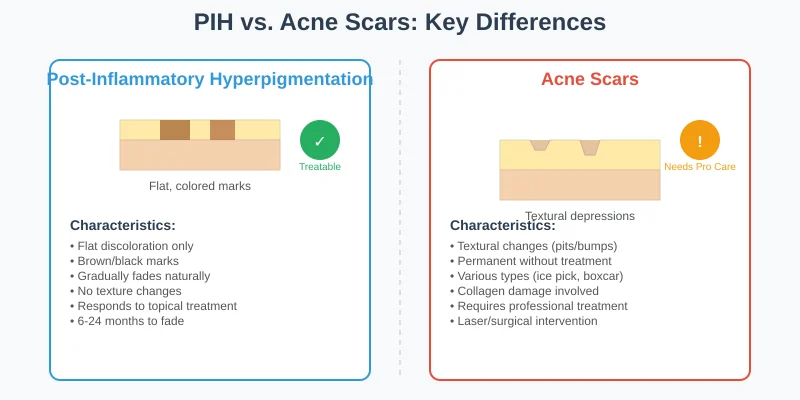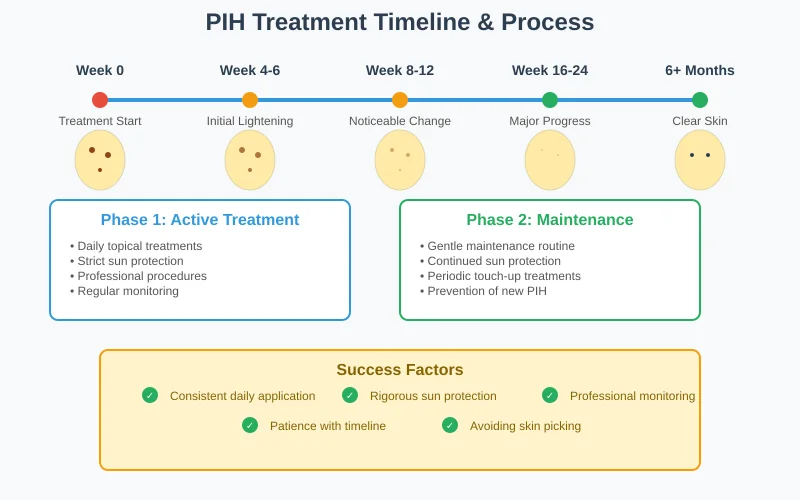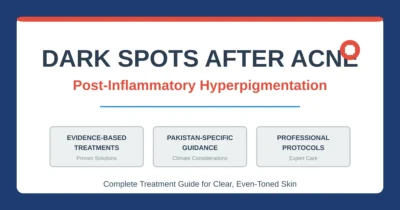Dark Spots After Acne: Post-Inflammatory Hyperpigmentation Explained
The frustration of clearing acne only to discover persistent dark spots can be overwhelming for many individuals. These stubborn marks, medically known as post-inflammatory hyperpigmentation (PIH), often prove more challenging to treat than the original acne itself, leaving behind a roadmap of past breakouts that can persist for months or even years without proper intervention.
In Pakistan’s diverse population, post-inflammatory hyperpigmentation presents unique challenges due to higher melanin content in darker skin tones, intense UV exposure, and genetic predisposition to pigmentation disorders. Understanding the science behind PIH formation and implementing evidence-based treatment strategies is essential for achieving clear, even-toned skin and preventing long-term scarring.
This comprehensive guide explores the mechanisms of post-inflammatory hyperpigmentation, effective treatment options, and prevention strategies specifically tailored for Pakistan’s climate and population genetics.
The Science Behind PIH Formation:
Post-inflammatory hyperpigmentation occurs when inflammation triggers an overproduction of melanin in response to skin injury or irritation. Unlike true acne scars, which involve changes in skin texture and structure, PIH dark spots represents a temporary increase in pigmentation that can gradually fade with time and appropriate treatment.
The inflammatory cascade begins when acne lesions trigger the release of inflammatory mediators, including prostaglandins, leukotrienes, and cytokines. These compounds stimulate melanocytes (pigment-producing cells) to increase melanin synthesis as a protective mechanism. In individuals with darker skin tones, this response is often more pronounced and persistent.
Key Factors in dark spots Development:
- Inflammation severity: Deeper, more inflamed lesions produce more persistent pigmentation
- Skin manipulation: Picking, squeezing, or aggressive treatment worsens inflammation
- Genetic predisposition: Family history of hyperpigmentation increases risk
- Skin phototype: Darker skin tones show higher PIH susceptibility
- Hormonal influences: Fluctuations can worsen pigmentation responses
Research published in the Journal of Clinical and Aesthetic Dermatology demonstrates that PIH affects up to 95% of individuals with darker skin tones who experience inflammatory acne, compared to 45% in lighter skin types.
PIH vs. Acne Scars: Critical Distinctions
Understanding the difference between post-inflammatory hyperpigmentation and true acne scarring is crucial for selecting appropriate treatments and setting realistic expectations.
PIH Characteristics:
- Flat discoloration: No changes in skin texture or elevation
- Color variations: Brown, black, or reddish marks depending on skin tone
- Gradual fading: Slowly improves over 6-24 months without treatment
- Uniform appearance: Consistent color throughout the mark
- Light responsiveness: Darker with sun exposure, lighter with protection
Acne Scars Characteristics:
- Textural changes: Raised (hypertrophic) or depressed (atrophic) areas
- Permanent nature: Requires professional intervention for improvement
- Various types: Ice pick, boxcar, rolling, or keloid formations
- Structural alterations: Changes in collagen organization and density
- Limited self-resolution: Minimal improvement without treatment

Risk Factors and Predisposing Conditions
Genetic and Ethnic Considerations:
Genetic factors play a significant role in PIH susceptibility, with certain ethnic populations showing markedly higher rates of post-inflammatory hyperpigmentation. South Asian populations, including Pakistan, demonstrate increased melanocyte reactivity and prolonged pigmentation responses.
- Fitzpatrick skin types IV-VI: Higher melanin content increases PIH risk
- Family history: Strong hereditary component in pigmentation responses
- Melasma susceptibility: Overlapping genetic factors with hormonal pigmentation
- Keloid formation tendency: Indicates exaggerated healing responses
- Previous hyperpigmentation: History of pigmentation disorders increases risk
Studies indicate that individuals of South Asian descent show 3-4 times higher rates of persistent PIH compared to Caucasian populations, with pigmentation lasting an average of 12-18 months longer.
Environmental and Lifestyle Triggers:
Pakistan’s environmental conditions create specific challenges for PIH prevention and management. The combination of intense solar radiation, pollution, and humidity can significantly worsen post-inflammatory hyperpigmentation.
Environmental Risk Factors:
- UV radiation exposure: Year-round intense sunlight stimulates melanin production
- Air pollution: Particulate matter causes oxidative stress and inflammation
- Heat and humidity: Increased sweating and inflammation potential
- Seasonal variations: Monsoon humidity affecting skin barrier function
- Occupational exposure: Outdoor work increasing sun damage risk
Lifestyle Contributing Factors:
- Inadequate sun protection: Insufficient SPF use or reapplication
- Aggressive skincare: Over-exfoliation or harsh product use
- Skin picking habits: Mechanical trauma worsening inflammation
- Delayed acne treatment: Allowing inflammation to persist
- Poor skincare routine: Inadequate cleansing or moisturizing
Comprehensive Treatment Approaches
Topical Treatment Strategies:
Evidence-based topical treatments form the foundation of PIH management, with specific ingredients targeting different aspects of pigmentation and cellular turnover.
First-Line Topical Agents:
Hydroquinone (2-4%): Considered the gold standard for hyperpigmentation treatment, hydroquinone blocks tyrosinase enzyme activity, reducing melanin production. Clinical studies show 60-80% improvement in PIH after 12-16 weeks of consistent use. Requires professional supervision due to potential side effects including irritation and paradoxical hyperpigmentation.
Tretinoin (0.025-0.1%): Prescription retinoids accelerate cellular turnover, helping to shed pigmented cells more rapidly while preventing new pigmentation formation. Research demonstrates 50-70% improvement in PIH when used consistently for 12-20 weeks. May cause initial irritation requiring gradual introduction.
Kojic Acid (1-4%): Natural tyrosinase inhibitor derived from fungi, offering gentler pigmentation control with lower irritation potential. Studies show 40-60% improvement in PIH with consistent use of Kojic Acid over 16-24 weeks. Well-tolerated in sensitive skin types.
Azelaic Acid (15-20%): Dual-action ingredient providing both anti-inflammatory and depigmenting effects. Particularly beneficial for ongoing acne with concurrent PIH. Clinical trials demonstrate 45-65% improvement in pigmentation with additional acne control benefits.
Advanced Combination Therapies:
Triple Combination Cream: Prescription formulations combining hydroquinone (4%), tretinoin (0.05%), and fluocinolone acetonide (0.01%) show superior results compared to individual agents. Studies demonstrate 70-85% improvement in moderate to severe PIH after 16 weeks.
Vitamin C Formulations: L-ascorbic acid (10-20%) provides antioxidant protection while inhibiting melanin synthesis. Most effective when combined with other depigmenting agents. Research shows 30-50% improvement as monotherapy, with enhanced results in combination protocols.
Niacinamide (2-5%): Vitamin B3 reduces inflammation and inhibits melanosome transfer, effectively lightening existing pigmentation while preventing new formation. Well-tolerated with minimal side effects, showing 25-40% improvement in PIH studies.
Professional Treatment Modalities:
Professional interventions offer accelerated results for moderate to severe PIH or when topical treatments prove insufficient.
Chemical Peels:
Glycolic Acid Peels (20-70%): Alpha-hydroxy acid peels promote rapid cellular turnover, effectively removing pigmented surface cells. Series of 4-6 treatments spaced 2-4 weeks apart typically show 60-80% improvement in PIH. Requires careful post-treatment care and sun protection.
Salicylic Acid Peels (20-30%): Beta-hydroxy acid peels penetrate oil-rich areas effectively, making them ideal for acne-prone skin with concurrent PIH. Anti-inflammatory properties provide dual benefits for active acne and pigmentation.
TCA Peels (10-25%): Medium-depth peels using trichloroacetic acid can address deeper pigmentation and provide more dramatic results. Requires experienced practitioner and extended recovery period but shows 70-90% improvement in resistant cases.
Jessner’s Peels: Combination peels using multiple acids provide controlled exfoliation with reduced downtime. Effective for superficial to medium-depth pigmentation with good tolerability.
Laser and Light Therapies:
Q-Switched Lasers: Nd:YAG (1064nm) and Alexandrite (755nm) lasers specifically target melanin in PIH without affecting surrounding tissue. Clinical studies show 60-85% improvement after 3-6 sessions with minimal downtime.
IPL (Intense Pulsed Light): Broad-spectrum light therapy targeting multiple pigmentation depths simultaneously. Gentler than lasers with gradual improvement over 4-6 sessions. Shows 50-70% improvement in PIH with additional benefits for skin texture.
Fractional Lasers: CO2 and Erbium fractional devices create controlled microscopic wounds, stimulating cellular renewal and collagen production. Effective for PIH with concurrent textural improvements, requiring 3-5 sessions.
Microneedling and Combination Therapies:
Microneedling with Topical Agents: Creating microscopic channels enhances penetration of depigmenting agents, improving treatment efficacy. Combination with vitamin C, kojic acid, or growth factors shows 40-60% enhancement over topical treatment alone.
Platelet-Rich Plasma (PRP): Autologous PRP contains growth factors that promote healing and cellular regeneration. When combined with microneedling, shows promising results for PIH with additional skin quality improvements.
Prevention Strategies and Maintenance
Sun Protection Protocols:
Rigorous sun protection represents the most critical factor in PIH prevention and treatment success. UV exposure can worsen existing pigmentation and stimulate new PIH formation even months after initial inflammation.
Comprehensive Sun Protection:
- Broad-spectrum SPF 30+: Daily application regardless of weather conditions
- Physical sunscreens: Zinc oxide and titanium dioxide preferred for sensitive post-acne skin
- Reapplication schedule: Every 2 hours during sun exposure
- Protective clothing: Long sleeves, hats, and UV-protective fabrics
- Seeking shade: Avoiding peak UV hours (10 AM – 4 PM)
Research demonstrates that consistent sun protection can reduce PIH duration by 40-60% and prevent recurrence in 85% of cases.
Early Acne Intervention:
Preventing PIH begins with prompt and effective acne treatment, minimizing inflammation duration and severity.
PIH Prevention Through Acne Management:
- Early treatment initiation: Addressing acne within first few weeks of onset
- Anti-inflammatory approaches: Prioritizing treatments that reduce inflammation
- Avoiding skin trauma: Gentle cleansing and no picking or squeezing
- Professional guidance: Dermatologist consultation for persistent acne
- Maintenance therapy: Continuing treatment to prevent new breakouts
Studies show that early, effective acne treatment reduces PIH (dark spots) risk by 70-80% compared to delayed or inadequate intervention.
Skincare Routine Optimization
Daily PIH Prevention Routine:
Morning Protocol:
- Gentle cleansing: pH-balanced, non-irritating cleanser
- Antioxidant serum: Vitamin C for protection and brightening
- Moisturizer: Lightweight, non-comedogenic formula
- Sunscreen: Broad-spectrum SPF 30+ as final step
Evening Protocol:
- Double cleansing: Thorough removal of sunscreen and impurities
- Treatment product: Retinoid or other prescribed depigmenting agent
- Hydrating serum: Hyaluronic acid or niacinamide
- Night moisturizer: Richer formula for overnight repair
Comprehensive Assessment at Derma & Dental Clinic:
Professional evaluation ensures accurate diagnosis and optimal treatment selection for individual PIH cases.
Diagnostic Services:
- Clinical examination: Detailed assessment of pigmentation type and distribution
- Wood’s lamp analysis: Enhanced visualization of pigmentation patterns
- Photographic documentation: Standardized imaging for progress monitoring
- Skin type assessment: Determining appropriate treatment intensity
- Medical history review: Identifying contributing factors and contraindications
Treatment Planning:
- Severity grading: Mild, moderate, or severe PIH classification
- Customized protocols: Tailored treatment combinations based on individual factors
- Timeline establishment: Realistic expectations and treatment duration
- Safety considerations: Minimizing risks in darker skin types
- Maintenance strategies: Long-term prevention and management plans
Advanced Treatment Options:
Combination Therapy Protocols: Our experienced dermatologists develop comprehensive treatment plans combining multiple modalities for optimal results:
- Topical + Professional: Chemical peels with prescription topicals
- Laser + Skincare: Q-switched laser treatments with medical-grade skincare
- Microneedling + Growth Factors: Enhanced penetration and healing
- Customized Formulations: Compounded treatments for specific needs
Monitoring and Adjustment:
- Regular follow-ups: Progress assessment every 4-6 weeks
- Treatment modifications: Adjusting protocols based on response and tolerance
- Side effect management: Prompt intervention for any adverse reactions
- Long-term planning: Maintenance strategies for sustained results
Expected Outcomes and Realistic Expectations
Understanding realistic expectations helps patients maintain compliance and satisfaction with PIH treatment.

Typical Improvement Timeline:
- 4-6 weeks: Initial lightening of pigmentation
- 8-12 weeks: Noticeable improvement in most patients
- 16-24 weeks: Significant improvement with consistent treatment
- 6-12 months: Maximum improvement with maintenance therapy
- Ongoing: Continued improvement with proper maintenance
Success Rates: Clinical data from our practice shows:
- Mild PIH: 80-90% significant improvement within 12 weeks
- Moderate PIH: 70-85% significant improvement within 16-20 weeks
- Severe PIH: 60-75% significant improvement within 24-32 weeks
- Maintenance success: 85-95% prevent recurrence with proper care
Factors Affecting Treatment Success:
Positive Prognostic Factors:
- Early treatment initiation: Beginning treatment within 3 months of PIH development
- Consistent compliance: Following prescribed treatment protocols exactly
- Adequate sun protection: Strict adherence to UV protection measures
- Professional guidance: Regular dermatologist supervision and monitoring
- Realistic expectations: Understanding that improvement takes time
Challenging Cases:
- Deep pigmentation: Darker, well-established marks require longer treatment
- Large affected areas: Extensive PIH may need combination approaches
- Ongoing acne: Active breakouts can interfere with PIH treatment
- Poor compliance: Inconsistent treatment application reduces effectiveness
- Sun exposure: Continued UV damage counteracts treatment benefits
Conclusion:
Post-inflammatory hyperpigmentation represents a common but treatable consequence of acne that can significantly impact quality of life and self-confidence. Understanding the mechanisms behind PIH formation, implementing evidence-based treatment strategies, and maintaining consistent prevention protocols are essential for achieving clear, even-toned skin.
Key takeaways for successful PIH management:
- Early intervention is crucial: Prompt acne treatment prevents PIH development
- Professional diagnosis ensures appropriate treatment: Distinguishing PIH from scars guides therapy selection
- Combination approaches work best: Multiple treatment modalities provide superior results
- Sun protection is non-negotiable: UV protection prevents worsening and recurrence
- Patience and consistency yield results: Most treatments require 3-6 months for optimal outcomes
- Maintenance prevents recurrence: Long-term skincare protocols ensure sustained improvement
At Derma & Dental Clinic, our experienced dermatologists provide comprehensive PIH treatment using advanced diagnostic tools, evidence-based therapies, and personalized care protocols. We understand the unique challenges faced by Pakistan’s diverse population and offer culturally sensitive, effective solutions for post-inflammatory hyperpigmentation.
Don’t let dark spots from past acne affect your confidence. Schedule a consultation today to develop a customized treatment plan that delivers real, lasting results for clearer, more even-toned skin.

